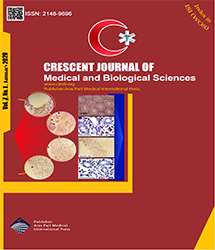
| Original Article | |
| The Effect of Acupressure on the Severity of Nausea During Hemodialysis | |
| Mohammad Reza Asgari1, Fatemeh Asghari2, Ali Asghar Ghods1, Raheb Ghorbani3, Nahid Hoshmand Motlagh1 | |
| 1Nursing Care Research Center, Semnan University of Medical Sciences, Semnan, Iran 2Student Research Committee, Semnan University of Medical Sciences, Semnan, Iran 3Social Determinants of Health Research Center, Semnan University of Medical Sciences, Semnan, Iran and Department of Epidemiology and Statistics, Semnan University of Medical Sciences, Semnan, Iran |
|
|
CJMB 2020; 7: 77–81 Viewed : 4978 times Downloaded : 3167 times. Keywords : Hemodialysis, Nausea, Acupressure |
|
| Full Text(PDF) | Related Articles | |
| Abstract | |
Objectives: Most patients bearing chronic renal failure (CRF) in end-stage renal disease (ESRD) need hemodialysis to survive. Although there are many advanced hemodialysis equipment, some of them still have complications. Nausea is general complicacy during hemodialysis, which leads to unsightly feeling. In this regard, the present study was conducted to investigate the effect of acupressure on the severity of nausea during hemodialysis. Materials and Methods: The current single-blind clinical trial was conducted on 60 patients in the dialysis wards of some selected hospitals affliated to Semnan University of Medical Sciences in Iran. The sampling method was easy, accessible, and purposive and the order of interventions was selected randomly. In addition, the nausea severity was measured during hemodialysis in one group in three different conditions of routine care, placebo administration, and acupressure. The verbal numerical rating scale was used to measure the nausea severity. To determine the difference in the mean of nausea severity in different conditions, repeated measures analysis of variance (ANOVA) test was used, followed by applying the post hoc test of Bonferroni for two-by-two comparisons in different conditions. Results: The mean of nausea severity was 1.15±2.08 in the routine care while it was 0.55±1.44 and 0.05±0.29 in placebo administration and acupressure conditions. The fndings of the repeated measures ANOVA test represented a remarkable difference among the mean severity of nausea in different conditions (P<0.001, F=11.61). Further, there was a signifcant difference between the mean of nausea severity in routine care compared to placebo administration (P=0.024) and acupressure (P<0.001) conditions. Finally, a signifcant difference was observed between the mean of nausea severity in placebo administration and acupressure conditions (P=0.030). Conclusions: The results demonstrated that acupressure was effective in attenuating the severity of nausea during hemodialysis thus using acupressure can be suggested to reduce nausea during hemodialysis. |
Cite By, Google Scholar
Google Scholar
PubMed
Online Submission System
 CJMB ENDNOTE ® Style
CJMB ENDNOTE ® Style
 Tutorials
Tutorials
 Publication Charge
Medical and Biological Research Center
About Journal
Publication Charge
Medical and Biological Research Center
About Journal
Aras Part Medical International Press Editor-in-Chief
Arash Khaki
Deputy Editor
Zafer Akan


















